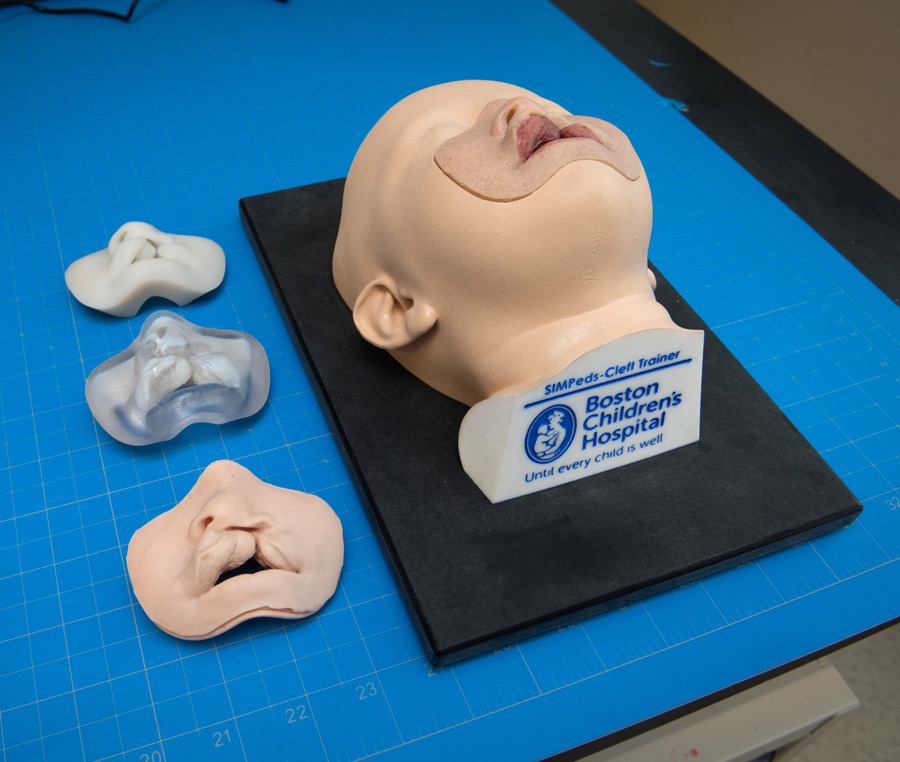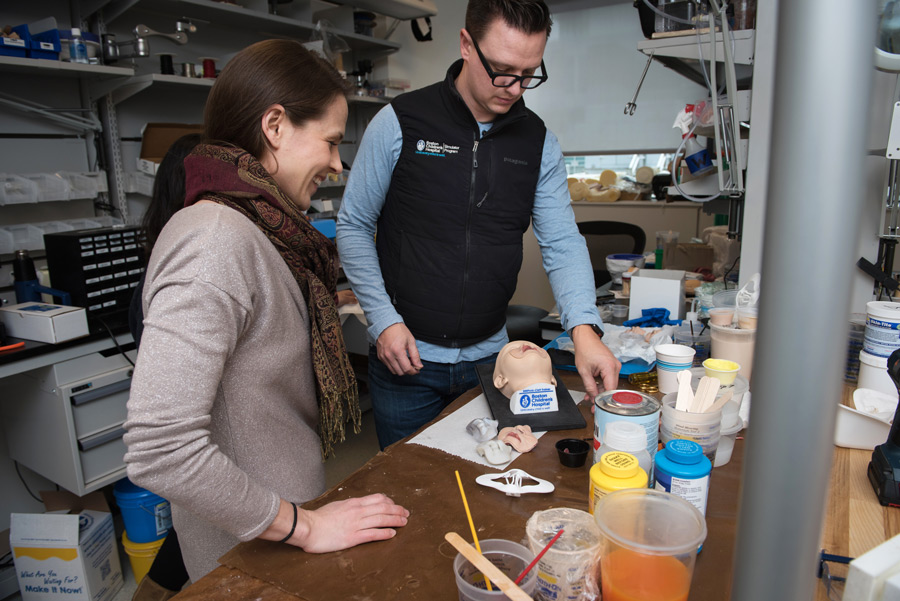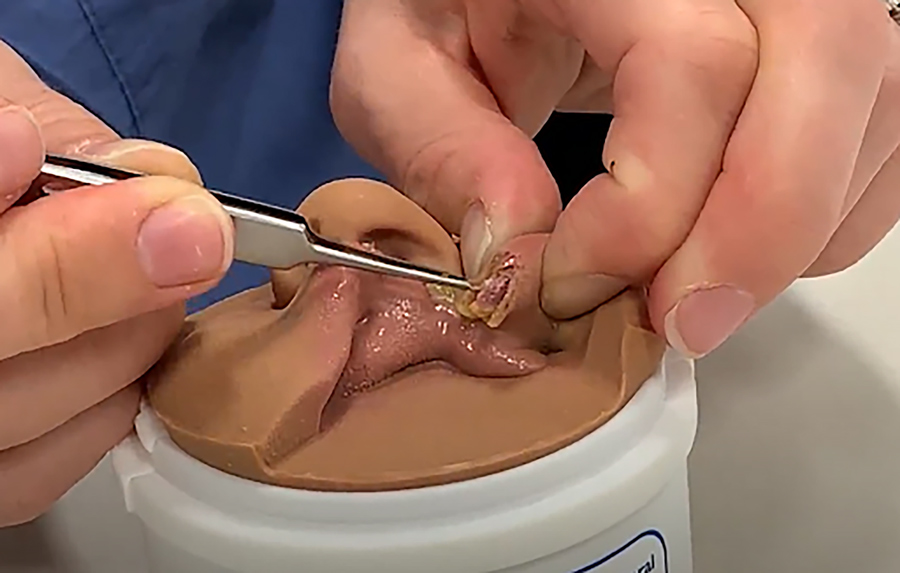Cleft lip simulation: A step closer to achieving surgical excellence
Surgical training is a long and laborious process, traditionally performed by learning to operate on actual patients under a senior surgeon’s supervision. However, with surgical techniques getting ever more sophisticated and standards of care increasing, it is not always easy for surgical trainees to access the required number of surgical cases. Surgical simulation has recently become the solution to this problem. Dr Carolyn Rogers-Vizena and her team at Boston Children’s Hospital, USA, have developed a surgical simulation model for cleft lip repair. So far, the model has helped to improve their department’s surgical education quality in both learning and teaching.
Until recently, surgery was learnt initially by observing and afterwards by operating on patients under supervision until a minimum number of cases were performed for each type of operation dictated by the surgeon’s speciality. However, this traditional type of learning is beginning to change since the introduction of surgical simulation.
Surgical simulators are sophisticated devices or systems that provide realistic digital recreations of surgical procedures or anatomical models of the human body while also allowing the surgical performance to be recorded and measured. Surgical simulation is a useful tool for surgeons around the globe since it enables surgical trainees to practise their skills in a safe and risk-free environment before they apply them to actual patients. It can also be helpful even for more experienced surgeons, especially when they need to master new techniques such as novel minimally invasive procedures.

In plastic surgery, more specifically, the importance of precise technique and consistency is imperative to achieving an aesthetically and functionally optimal result. This challenge led Dr Carolyn Rogers-Vizena at Boston Children’s Hospital, USA, a surgeon with expertise in repairing cleft lip in children, to collaborate with a team of engineers and artists with an aim of developing a high-fidelity cleft lip repair surgical simulator.
15 out of 16 trainees felt that the addition of simulation training to their curriculum was much more fruitful than traditional training alone.Creating a life-like simulator
Cleft lip is a split in the upper lip that can extend to the palate and base of the nose. It is a common birth defect caused by the incomplete development of the facial structures in the foetus. The treatment is surgical repair during infancy performed under general anaesthetic.
With the aim of improving surgical training for the specific procedure in their department, the team initially designed a digital simulated patient with a complete one-sided cleft lip. To create a detailed and anatomically accurate high-fidelity cleft simulation, they used information from previous three-dimensional imaging studies of children’s faces. Based on this ‘digital patient’, the team then built a model of a child’s face made from materials with a feel and behaviour similar to bodily tissues, such as silicone and synthetic polymers.

Next, three different surgeons tried the simulator each using their own technique for the repair. All three surgeons found the model realistic in terms of the detailed anatomy and resemblance to real human tissues. The results were then digitally processed, analysed, and compared to those of real operations the same surgeons had performed. The outcome of the analysis and comparison confirmed an accurate replication of the anatomical structures and the procedure, including the surgeons’ moves and steps followed.
The creation of the high-fidelity simulator provided the trainees of the department with a great opportunity to practise all the steps of the cleft repair before they were called to do it in the operating room. The encouraging results led to the formation of a surgical trainee programme that put the simulator to good use. A pilot study involving sixteen trainees was conducted and the results revealed a significant improvement of the participants’ surgical knowledge for the specific procedure. In the end, all of them agreed that practising on the simulator helped them learn, and 15 of them (94%) felt that the addition of simulation training to their curriculum was more fruitful than traditional training alone.

Testing surgical competence
After the successful development of their high-fidelity simulator, the team felt they also needed to evaluate whether their simulator could be used to assess a surgeon’s technical skills. This time, the participating plastic surgery trainees performed one repair on the simulator which was video recorded and rated blindly by two senior surgeons using objective scoring systems. Simulators were also analysed using digital methods to evaluate the facial symmetry of the end result. The team was surprised to find out that the lip repair symmetry levels were not relevant to the seniority and experience of the surgeons participating, but the performance of key steps of the operation were. They concluded that the high-fidelity simulator could be used in combination with the appropriate assessment tools to reliably evaluate a surgeon’s skills. However, symmetry of the cleft lip repair was not as useful a tool for discriminating competence as they had hoped.
The researchers designed a cost-effective version of the simulator, which was well-received at an international cleft lip repair workshop.Training the trainers
By closely observing and recording their trainees’ virtual operations, the senior surgeons were surprised to notice that some steps of the procedure were either not followed at all or were followed insufficiently. This revelation made the team think that the way they had been teaching surgery has faults, something they decided to investigate further.
They analysed the data from this previous study, which included anonymised videos of the trainees’ procedures and the ratings allocated to them by the senior surgeons using a specific rating score tool. They also analysed the scores looking for assessor’s bias. The results identified which steps of the cleft lip repair were taught well at their department and which ones required improvement, such as the surgical closure of the split near the base of the nose. By understanding their weaknesses, the surgical trainers could focus more on teaching these problematic steps using a variety of methods such as videos from operations and simulation techniques.

But does it improve performance?
The encouraging findings of these initial studies made the researchers wonder if practising on the high-fidelity simulator actually improves surgical skills and whether it prepares the plastic surgery trainees for safely performing their first actual cleft lip repair on a real patient. To achieve this, they recently conducted an experiment involving plastic surgery trainees of various seniority levels who performed multiple cleft lip repairs followed by structured feedback over a period of several months. All procedures were recorded and blindly rated by a senior surgeon. The surgical performance was graded using special technical assessment tools and the trainees also had to rate themselves and their confidence levels after each procedure using reliable scoring tools.
Preliminary results of this study revealed that the second attempt at cleft lip repair overall significantly improved compared to the first one, while they stayed the same or dropped only a little bit during the third simulation. Further analyses are underway to better understand the true impact of simulation, but these early findings make the team hopeful that using their simulator in combination with structured feedback can help improve the trainees’ technical skills for cleft lip repair and give them the confidence required for performing procedures like this on real patients.
Making a worldwide contribution
For Rogers-Vizena and her team, the experience of developing the high-fidelity cleft lip repair simulator (and the research projects it inspired) have improved the teaching of cleft lip repair in their department. They feel that their experience and their deep analysis of all the relevant data accumulated over the past eight years can be used to improve teaching of cleft lip repair in hospitals around the world. Making strides in this direction, the researchers have reduced the device’s building cost and designed a cost-effective version of the simulator, which was well-received at an international cleft lip repair workshop. They are looking forward to sharing their success with the surgical world and hope that their new model will make simulation training more accessible for as many hospitals and healthcare systems as possible.


Personal Response
What initially inspired you to develop the simulator?
In my first couple of years as an attending surgeon, I often thought it would be very useful to have the ability to practice cleft lip repair and try out new techniques in a risk-free environment. After getting to know some of the artists and engineers working in the Boston Children’s Simulator Program, it became apparent that by collaborating together, we could make that desire a reality.
How can surgical simulation optimally be applied to plastic surgery education?
Because cost is a factor with technologies such as simulation, it should be used as efficiently as possible. Our research has led me to believe that simulation has the greatest impact for junior learners. So, in an ideal scenario, simulation would be incorporated into surgical education early to develop a basic level of competency that allows trainees to maximise the educational impact of their future clinical experience.